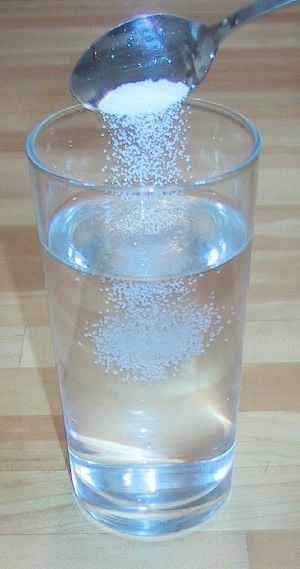Solution (chemistry)
- This article is about a chemical solution; for other uses of the term "solution", see solution (disambiguation).
In chemistry, a solution is a homogeneous mixture composed of one or more substances, known as solutes, dissolved in another substance, known as a solvent. A common example is a solid, such as salt or sugar, dissolved in water, a liquid. Gases may dissolve in liquids, for example, carbon dioxide or oxygen in water. Liquids may dissolve in other liquids and gases in other gases.
Examples of solid solutions are alloys and certain minerals.
Ideal solutions
An ideal solution is one where the interactions of the molecules of the solvent with each other are equal to their interactions with the solutes. The properties of an ideal solution can be calculated by the linear combination of the properties of its components.
The solvent is If both solute and solvent exist in equal quantities (such as in a 50% ethanol, 50% water solution), the concepts of "solute" and "solvent" become less relevant, but the substance that is more often used as a solvent is normally designated as the solvent (in this example, water).
Solvents
Solvents can be broadly classified into polar and non-polar solvents. A common measure of the polarity of a solvent is the dielectric constant. The most widely used polar solvent is water, with a dielectric constant of 78.5. Ethanol, with a dielectric constant of 24.3, has intermediate polarity. An example of a non-polar solvent is hexane, which has a dielectric constant of 1.9. Generally polar or ionic compounds will only dissolve in polar solvents. A simple test for the polarity of a liquid solvent is to rub a plastic rod, to induce static electricity. Then hold this charged rod close to a running stream of the solvent. If the path of the solvent deviates when the rod is held close to it, it is a polar solvent. Certain molecules have polar and non-polar regions, for example sodium dodecyl sulfate. This class of molecules (called amphipathic molecules) includes surfactants like soaps and emulsifiers, as they have the ability to stabilize emulsions by aligning themselves on the interface between the non-polar and polar liquids, with their polar ends in the polar liquid and their non-polar ends in the non-polar liquid.
Solvation
During solvation, especially when the solvent is polar, a structure forms around it, which allows the solute-solvent interaction to remain stable.
When no more of a solute can be dissolved into a solvent, the solution is said to be saturated. However, the point at which a solution can become saturated changes significantly with different environmental factors, such as temperature, pressure, and contamination. Raising the solubility (for example by increasing the temperature) to dissolve more solute, and then lowering the solubility causes a solution to become supersaturated.
In general the greater the temperature of a solvent, the more of a given solid solute it can dissolve. However, some compounds exhibit reverse solubility, which means that as a solvent gets warmer, less solute can be dissolved. Some surfactants exhibit this behaviour. The solubility of liquids in liquids is generally less temperature-sensitive than that of solids or gases, while gases usually become less soluble with increasing temperature.
Concentration
There are several ways to measure the strength of a solution; see concentration for more information. Total dissolved solids is a common term in a range of disciplines, and can have different meanings depending on the analytical method used. In water quality, it refers to the amount of residue remaining after evaporation of water from a sample.
Types of solutions
| Examples of solutions | Solute | |||
|---|---|---|---|---|
| Gas | Liquid | Solid | ||
| Solvent | Gas | Oxygen and other gases in nitrogen (air) | Water vapor in air (humidity) | The odor of a solid results from molecules of that solid being dissolved in the air |
| Liquid | Carbon dioxide in water (carbonated water) | Ethanol (common alcohol) in water; various hydrocarbons in each other (petroleum) | Sucrose (table sugar) in water; sodium chloride (table salt) in water; gold in mercury, forming an amalgam | |
| Solid | Hydrogen dissolves rather well in metals; platinum has been studied as a storage medium | Water in activated charcoal; moisture in wood | Steel, duralumin, other metal alloys | |
ReferencesISBN links support NWE through referral fees
Streitwieser, Andrew and Heathcock, Clayton H., Kosower, Edward M. (1992). Introduction to Organic Chemistry, 4th ed., Macmillan Publishing Company, New York. ISBN 0-02-418170-6.
See also
- Colligative properties
- Colloid
- Molar solution
- Percentage solution
- Solubility equilibrium
- Solubility
- Suspension (chemistry)
- Solution (problem)
ca:Solució química cs:Roztok da:Opløsning (kemi) de:Lösung (Chemie) et:Lahus el:Διάλυμα es:Soluto eo:Solvo fr:Solution (chimie) ko:용액 io:Dissolvuro it:Soluto he:תמיסה hu:Oldat mk:Раствор nl:Oplossing (scheikunde) no:Løsning ja:溶液 pl:Roztwór pt:Soluto ru:Раствор fi:Liuos th:สารละลาย uk:Розчин zh:溶液

